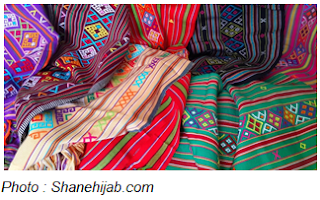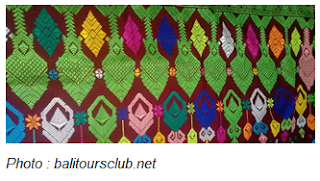Woven fabrics as a sustainable cultural heritage
Talking
about traditional woven fabrics found in Indonesia seems to never end. That is
indeed a fact, how about not if almost all areas inhabited by children of
different tribes must be there
has a
cultural heritage in the form of woven fabric. Every tribe in each region, has
different workmanship techniques, raw materials, patterns, and motifs. Alright,
let's talk about it one by one.
Troso
Woven Fabrics from Central Java
The Jepara
Regency area consists of several sub-districts, in some sub-districts, many
people live as craftsmen. In one sub-district there is a village known as a
teak wood carving craftsman and in another village known as a Traso woven
fabric craftsman.
Troso woven fabric is woven from the Troso area, Jepara district in Central Java. It is not known with certainty when and how the origin of Troso woven fabric was, but there are allegations that Troso weaving was influenced or even brought from eastern Indonesia, such as Sumba in West Nusa Tenggara and Timor Island in East Nusa Tenggara. The record only mentions the Troso woven fabric made by the Troso village community since the early 20th century.
When it is
known as it is now, Tenun Troso applies the ikat technique, although at first
the people in this village used the Gedok technique for the weaving process.
The difference between the Gedok weaving technique and the Ikat weaving
technique lies in the technique of dyeing the yarn.
In the
Gedok weaving technique, the yarn in the skein is completely immersed in the
dye, so that each skein of yarn represents one color. The technique of coloring
in Ikat Tenun is to tie the thread in a knot according to the planned pattern,
the knot that has been formed is then carefully dipped one by one in the dye
liquid. The purpose of tying the thread into a knot is as a barrier so that the
dye does not hit other parts.
The pattern theme that was raised in the Troso weaving motif was initially in the form of classic themes such as taro leaves, fir trees, and nagasari, but in line with time, many contemporary themes are used.
Buna Insana Weaving Fabric from Timor Island
In East
Nusa Tenggara there is a cultural heritage that the residents of the area are
proud of, the cultural heritage is in the form of weaving fabrics that are made
by residents based on the skills taught by their ancestors long ago.
The richly colored Insana woven fabric has two types of patterns, the first is the Sotis pattern and the second is the Buna pattern. In the Sotis pattern, the weaving pattern focuses on the form of ribbons or straight lines in the reflection motif. Another motif placing the same two images in two different spaces, opposite each other or facing each other.
In the Buna pattern, the motif depicts a geometric shape in the form of a rectangle and a diamond as outlined in the reflection motif.
The specialty of Insana weaving is that it is made with hand embroidery techniques, in addition to the use of color, Insana weaving uses bright colors that represent joy. One more thing, Insana's woven fabric visually looks artistic in its strong beauty.
Currently, Insana woven fabrics are available in two types of raw material preparations, the first using raw materials in the form of cotton which is traditionally processed into yarn, and the second from raw materials in the form of fabricated yarn.
Weaving
Rangrang Nusa Penida
So far,
people only know about Balinese weaving in general, even though Balinese
weaving has various styles that come from different cultural roots. Some
examples of Balinese woven fabrics are Gringsing weaving fabrics, Balinese
Songket weaving fabrics, and Endek weaving fabrics. There is one more type of woven
fabric that has escaped attention, namely Rangrang weaving, Rangrang weaving is
produced by the people who inhabit the island of Nusa Penida in the southeast
of the island of Bali.
The island
of Bali and the island of Nusa Penida is separated by the Badung Strait at a
distance of about 35 km (about 18 miles). To get to Nusa Penida Island from
Bali you can use sea transportation (ferry, boat, or speed boat).
The bright
colors of red, orange, and purple are the hallmarks, which makes the Rangrang
weaving look festive. The pattern that dominates the weaving of Rangrang is a
geometric pattern that describes the hilly and mountainous landscape of Nusa
Penita. Another characteristic that marks the weaving of Rangrang is the small
holes in the woven fabric
Before the
name Rangrang weaving was known, the people of Nusa Penida called this woven
cloth the name Cerik-bolong which means holes or translucent. Then the name
Cerik-bolong changed to Nyrangnyang and finally became Rangrang weaving as it
is known today. In doing this Rangrang weaving, craftsmen in Nusa Penida use a
traditional loom called Cagcag.
If you have
the opportunity to see the current Rangrang weaving collection, you will see
various contemporary motifs with more variations, including rainbow motifs,
stripes, rectangles, diamonds, crosses, and several other motifs. There are two
preparations for the use of color, the first is Rangrang woven with natural
dyes and the second is Rangrang woven with synthetic dyes.
Get rewarded as a contributor*
WFH projects can be done from anywhere, if you are suitable
and approved you can work on the projects offered, the rewards are not bad
between 100 – 250 US$. Before viewing and selecting available projects, you
register first at this link.
Projects (short- or long-term ); Search and Social Media
Evaluation; Translation and Transcription Services; Linguistic Specialties; Speech
Evaluation; Micro Tasks; Surveys and Data Collection; Data
Annotation (for images, audio, video, and more)



Post a Comment for "Weaving Fabrics Showing the Unique Culture of Various Regions in Indonesia"